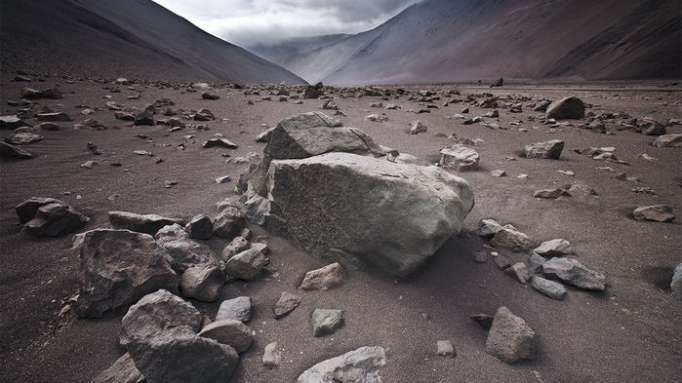The work “does a good job of justifying that these organisms really do live there,” says Julie Neilson, an environmental microbiologist at the University of Arizona in Tucson who was not involved with the study. The Atacama Desert may be uninhabitable for us, but for these organisms, “it’s their ecosystem,” she says.
The Atacama Desert stretches inland 1000 kilometers from the Pacific coast of Chile, and rainfall can be as low as 8 millimeters per year. There’s so little precipitation that there’s very little weathering, so over time the surface has built up a crusty layer of salts, further discouraging life there. “You can drive for 100 kilometers and not see anything like a blade of grass,” Neilson says. Although she and others have found some bacteria there, many biologists have argued that those microbes are not full-time residents, but were blown in, where they die a slow death.
But that didn’t deter Dirk Schulze-Makuch, an astrobiologist at the Technical University of Berlin. “I like to go to places where people say nothing is alive,” he says. “We decided to take a shotgun approach and throw all the new [analytical] approaches at everything—fungi, bacteria, viruses”—that might be there.
He and his team collected samples from eight places in the Atacama—from the coast eastward to the driest places—over 3 years. They first gathered material a month after a record-setting rain in 2015, and then followed up with yearly collections in some of the same places in 2016 and 2017. They sequenced all the copies of a gene known to distinguish microbial species to determine what was in those samples and even recovered some full genomes. The researchers also did a test to determine the proportion of DNA that came from intact, living cells. Finally, they assessed the amount of cellular activity; of adenosine triphosphate (ATP), a molecule the fuels this activity; and of byproducts—including fatty acids and protein building blocks—that resulted from that activity to look for additional evidence of life.
The coastal samples contained the most number and diversity of microbes, but in 2015, there were signs of life even in the driest spots, Schulze-Makuch and his colleagues report today in the Proceedings of the National Academy of Sciences. “Following a rainfall event, there is a flush of activity and [cells] are replicating,” Neilson says.
Overall, the coast proved most hospitable in both rainy and dry years: In general, the amount of ATP was 1000 times greater than more inland sites and the amount of breakdown products followed a similar trend, the team reports. The genomes showed, too, that at least a few bacteria were reproducing in the coastal regions and perhaps elsewhere.
Over the subsequent 2 years, which were mostly dry, those amounts declined everywhere, especially in the drier places. By 2017, signs of life had virtually disappeared in most places, with intact DNA being more than 100,000 times less common at the driest spot. But some bacteria continued to thrive 25 centimeters below ground there, Schulze-Makuch notes.
In their survey, the researchers only identified the bacteria whose DNA resembled DNA already in microbial databases. So what they found in the Atacama were familiar to some degree. During the wet year, bacteria along the coastal region resembled the microbial community typical of sandy soils. DNA from drier areas belonged mostly to bacteria found in very dry deserts or in salt flats. They likely survive as spores or as cells that are barely functioning at all.
That these organisms can be dormant seemingly indefinitely gives Neilson and Schulze-Makuch hope that a few are doing the same on Mars, perhaps egged on by nightly snowfalls that he says happen there. Thus, he says, the Atacama Desert “can serve as a working model for Mars.”
Read the original article on sciencemag.org.
















































